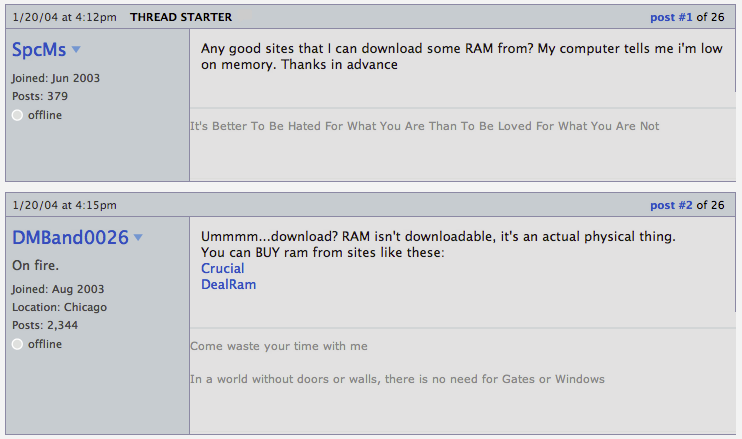Can You Really Download More RAM?
It's a joke as old as the internet itself: Can you download more RAM?.

Apple Insider user SpcMs asking where to download more RAM
Originating from a 2004 Apple Insider thread, it gained traction through tech forums and memes, eventually leading to parody sites like DownloadMoreRam.com . The history of downloadable RAM, or unconventional ways to increase RAM, goes way earlier, to the likes of SoftRAM .
SoftRAM and its successor SoftRAM95 were software utilities sold in the 1990s that claimed to increase the available memory of a computer without any hardware upgrades; though in reality, they offered no real performance improvements and were ultimately exposed as scams.
SoftRAM95 sold more than 600,000 copies, at an equivalent of $62.81 ($30 in 1995) each, generating over $37 million in revenue. In late 1995, the U.S. Federal Trade Commission (FTC) charged the company behind SoftRAM95, Syncronys Softcorp, with false advertising. The FTC alleged that the software did not actually increase usable RAM, contrary to the company's claims.
So the question remains: can you download more RAM? Well, it depends. While it's technically possible to virtualize or forward devices like RAM, CPU, or GPU over Ethernet; similar to how USB-over-IP works; the idea quickly breaks down when you consider latency and bandwidth requirements. Accessing a local RAM module or CPU register happens on the nanosecond scale (1-10 ns), and even the slowest internal buses on modern machines operate in the tens to hundreds of nanoseconds. In contrast, even a high-speed gigabit Ethernet connection has a baseline latency of 0.1 to 1 milliseconds (100,000-1,000,000 nanoseconds), which is orders of magnitude slower. Simply put, hardware designed to be accessed in nanoseconds becomes unusable when saddled with network-scale latencies and jitter.
Take the CPU as an example. A modern processor can execute billions of instructions per second (e.g., a 3 GHz CPU performs 3 billion cycles per second). Now imagine introducing just 0.1 milliseconds (100,000 nanoseconds) of network latency between each instruction or memory access. That would be like asking your CPU to wait 10,000 times longer than usual before completing each operation.
The performance drop wouldn't just be noticeable; it would be catastrophic. It's like replacing your internal wiring with a postal service. This is why CPU, RAM, and GPU virtualization over Ethernet is not just impractical; it's fundamentally incompatible with how these components are meant to operate. Unless Quantum internet becomes a reality and brings us instantaneous communication, the idea of downloading more RAM is a myth that will remain just that: a myth.
Distributed Computing with Distributed Virtual Machines
Virtual machines like the JVM use higher-level instruction sets compared to physical CPUs. Each JVM bytecode instruction can represent a complex operation; such as object creation, method invocation, or array manipulation; that would translate into dozens or hundreds of actual CPU instructions.
This abstraction makes VMs more portable and easier to optimize at runtime, but it doesn't make them suitable for distributed execution either. Even with fewer instructions, each one still depends heavily on tight, sequential access to memory and control flow.
Trying to execute even these higher-level instructions over a network introduces unacceptable latency and synchronization overhead. The cost of sending an instruction, waiting for a result, and continuing the execution flow remotely would destroy performance; the time it takes to send a single instruction over the network could be longer than executing millions of CPU cycles locally.
In fact, my journey into distributed computing; and what eventually evolved into Timeleap; began back in 2009, when I built a distributed virtual machine designed to run LISP programs. I wrote both the VM and its LISP compiler, experimenting with ways to execute code across multiple machines in parallel.
I soon learned that this approach simply wasn't feasible; even with machines connected over Ethernet on the same local network, less than a meter apart. The overhead of network communication, no matter how small, introduced enough latency to make fine-grained instruction-level distribution completely impractical.
Component-based Distributed Computing
The solution to this problem lies in a different approach: component-based distributed computing. Instead of trying to distribute individual instructions or operations, we focus on distributing entire components or services that can operate independently.
The idea of component-based design really took off in the world of web development. Frameworks like React popularized the concept of breaking down user interfaces into self-contained, reusable components; each responsible for managing its own state and behavior.
This modular approach made complex applications easier to build, reason about, and scale. As frontend ecosystems evolved, this mindset spread beyond just UI; it influenced everything from backend services to infrastructure. Watching this shift unfold, I was inspired by how cleanly decoupled components could be developed, deployed, and even rendered in isolation; yet still work together seamlessly.
That same philosophy applies beautifully to distributed computing. Just like a UI is made up of independent components that communicate through well-defined interfaces, a distributed compute system can be composed of independent processing units; each handling its own workload, communicating only when needed, and scaling horizontally.
By thinking of computation as a graph of components instead of a monolithic program or instruction stream, we can build systems that are both distributed and performant; not by splitting cycles, but by splitting responsibilities.
Put simply, this approach means building applications out of small, self-contained pieces that can run on their own; like Lego blocks that each do a specific job. Instead of writing one big program that runs on one machine, you create a bunch of smaller programs (or components), each responsible for a particular task, and let them run wherever there's available compute power.
Imagine a multiplayer game: instead of one giant server handling everything, you could have separate components; one for physics, one for chat, one for matchmaking, one for player stats; each running on different machines, scaling independently as needed. The game becomes a collection of smart, connected modules that can grow, heal, and evolve without central bottlenecks.
One of the biggest advantages of this model is reusability. Once a component is built to perform a specific function; whether it's handling user authentication, running a physics simulation, or processing in-game purchases; it can be reused across multiple applications without rewriting it from scratch. Just like UI components can be dropped into different pages or projects, compute components can be plugged into entirely different systems.
For example, a leaderboard service built for one game could be reused in another, or a trading engine designed for a strategy game could power the economy in a simulation app. This not only speeds up development, but also encourages better, more reliable design; because each component improves over time as it gets reused in different contexts.
Another powerful aspect of component-based computing is that it's technology agnostic. Each component can be written in a different language or built using a different framework; whatever best suits the job. One component might be a Go service handling real-time updates, another a Python-based ML model, and another a Rust module for performance-critical logic. Because components communicate through well-defined interfaces, the underlying technology doesn't matter. This gives developers the freedom to use the right tool for each task, without being locked into a single stack or platform.
At Timeleap, we've built a suite of products that make it easier to develop, deploy, and run applications as distributed compute components. This is our approach to distributed computing; not just theory or architecture, but a real, working system. Developers build applications like they're assembling a puzzle: each component is a piece of logic, a service, or a runtime environment. If a piece is missing, you can build it yourself and connect it to the rest. This modular, composable approach unlocks a new way of building apps, where flexibility, performance, and scale come from the structure of your system, not the size of your server.
To support this, Timeleap is building a full ecosystem of components through the Timeleap Component & App Marketplace. This is where developers can publish, version, discover, and reuse components across different apps and teams; just like packages in a modern software registry. Whether you're creating a leaderboard system, a payment handler, or a rendering pipeline, each component can be shared and plugged into other applications. This will make distributed development not only possible, but practical and scalable, bringing the same modularity we see in frontend development to the world of compute infrastructure.
Remote Software Access vs. Distributed Computation
Remote software access; like game streaming, remote desktops, or tools like Parsec and Shadow; means running a full application on one machine and sending the visual output over the network. Your keyboard, mouse, and controller inputs are sent to the remote system, and in return, you see a video stream of what's happening. The app itself still runs in one place, as a monolithic process. It's convenient, but you're still dependent on a central server doing all the heavy lifting.
Distributed computation, on the other hand, breaks the application into smaller pieces that can run independently on different machines. It's not about streaming visuals from a powerful computer; it's about spreading the actual workload itself. Instead of one game server handling everything, a distributed game might offload physics to one node, AI to another, and in-game voice chat to a third. Each part runs natively on a different machine, and they talk to each other over the network to keep the experience seamless.
In other words, remote access is centralized execution with a remote screen, while distributed computation is decentralized execution with shared responsibility.
That said, fully distributed applications are still the future; but we won't be there overnight. There are countless traditional apps, tools, and games built with centralized assumptions, and they won't magically transform into distributed components.
That's why Timeleap will also provide robust tooling to run traditional apps remotely, so developers and users can still benefit from the network without rewriting everything from scratch. Whether it's a legacy desktop app or a high-performance game, our platform will support remote execution as a first-class feature, bridging the gap while we collectively move toward a truly distributed software model.
Conclusion
So, can you download more RAM? Not really; at least not in the way the meme suggests. But what you can do is rethink how we use compute altogether. Rather than trying to virtualize hardware over a network, the real breakthrough lies in distributing computation intelligently. That's exactly what we're doing with Timeleap Network: building a future where software runs not on a single device, but across a global, modular compute fabric — one component at a time.
Today, we've completed the underlying infrastructure and SDKs that power the Timeleap Network. The technology is here, and we're now shifting our focus to building the ecosystem around it. Our first area of focus is gaming; not only because games demand high performance and modularity, but also because they're the perfect proving ground for decentralized systems: real-time physics, chat, matchmaking, user data, and more can all run as separate components across the network. It's a playground where the strengths of our approach truly shine.
Our upcoming console will showcase this in action, starting with hybrid local and distributed compute. We know this transformation won't happen overnight — that's why we're building support for both traditional use cases, hybrid, and fully distributed apps. Every part of the experience, from the OS messaging system, notifications, and app marketplace to AI assistants and background services, will be powered by the Timeleap Network.
We're just getting started. If you're curious to see how it works or want to get involved early, learn more about Timeleap Network here and help us build the future of computation.

Pouya Eghbali
2025-03-29
Founder & CEO at Timeleap
Timeleap SA.
Pl. de l'Industrie 2, 1180 Rolle, Switzerland

 Home
Home